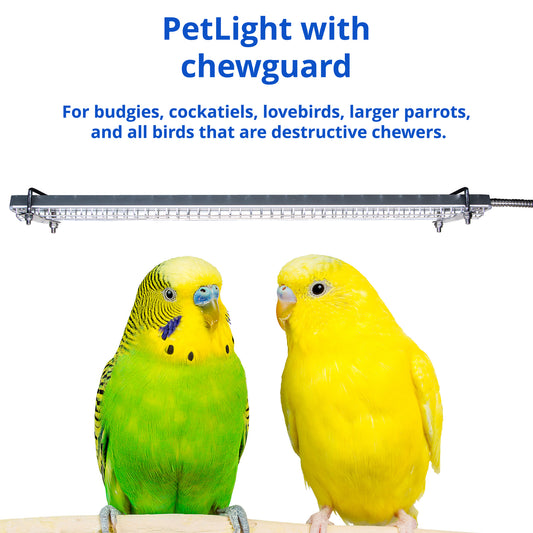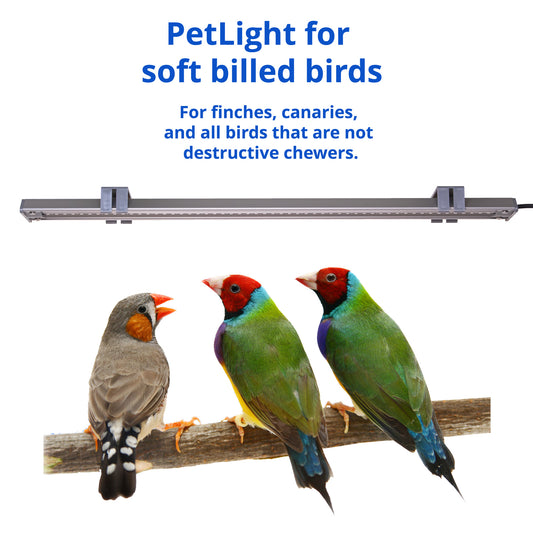How to Choose the Right Light Fixtures for Your Bird Room
Share
When building the perfect bird room or cage setup, lighting is often overlooked — but it’s one of the most important environmental cues your bird receives daily.
The fixture you use to deliver light matters just as much as the light itself.
From mounting and safety to placement and durability, here's how to choose a bird light fixture that actually works for your bird — not against them.
🧱 Not Just Brightness — but Direction and Placement
Light only helps your bird if it reaches inside the cage. Room lights or ceiling fixtures may seem bright to us, but their effect drops drastically through cage bars, perches, and accessories.
“Even a brightly lit room will not supply the amount of light birds prefer inside their cage.”
Solution? Use fixtures that mount directly to or above the cage, angled in a way that floods the bird’s living space evenly — without shadows or bright spots.
A consistent, directional light source helps reinforce the natural day/night rhythm your bird instinctively relies on.
🛡️ Fixtures Must Be Built Bird-Tough
Birds don’t just sit and observe their space. They explore it — with their feet, beaks, and bodies.
Any fixture in or around your bird’s environment should be:
-
✅ Chew-proof: Including metal or stainless steel housings and bite-resistant cable coverings
-
✅ Shock-resistant: Avoid brittle plastic clips or lamp arms
-
✅ Securely mountable: Lights should stay stable with no swinging or tipping
-
✅ Fully shielded: No exposed wires, sockets, or glass
Even small birds will nibble — and large parrots can cause real damage. Your fixture should withstand both curiosity and chaos.
🪶 Why Mounting Angle and Spread Matter
A good bird light fixture doesn’t just hang above the cage — it targets the area where your bird spends time. This means:
-
Horizontal, overhead placement
-
Beam spread wide enough to cover the whole cage
-
No harsh hotspots or dark corners
-
Adjustability, so you can shift the light as needed
If a bird feels "in the spotlight" from one side or has nowhere shaded to retreat, it can increase stress. Uniformity matters.
🚫 Fixtures and Setups to Avoid
-
❌ Clip-on desk lamps – unstable and often flicker
-
❌ Reptile heat lamps – may emit UVB or intense heat
-
❌ Dangling cables – invite chewing and safety risks
-
❌ Wall or ceiling lights alone – don’t reach the cage interior
-
❌ Exposed LED strips – too bright, often too narrow in spectrum
🧰 What Makes HappyBird Fixtures Different
HappyBird fixtures are designed only for birds. That means:
-
A broad visible light spectrum, no UVB
-
Sturdy, bird-proof mounts that attach directly to the cage
-
Integrated chew protection and durable housings
-
Flicker-free performance, tested for bird vision
-
Plug-and-play simplicity with safe, low-voltage setups
They’re made to be part of your bird’s life — not a temporary DIY solution.
🔁 Routine Matters: Use Fixtures to Reinforce Rhythm
Birds rely on routine and consistency. A reliable bird light fixture helps deliver:
-
⏲️ 10–12 hours of daylight during all seasons
-
☀️ A sun-like light intensity inside the cage
-
🌙 A clear transition to rest when the light turns off
HappyBird fixtures support this rhythm effortlessly, with options for timers, dimmers, and future smart home integration.
🧩 Conclusion
Choosing a bird light fixture isn’t just about brightness — it’s about safety, stability, and smart positioning.
When done right, your bird's lighting becomes a seamless part of their environment — helping them feel secure, active, and in sync with the day.
Go beyond “bright enough.” Choose a fixture that’s built for birds.




